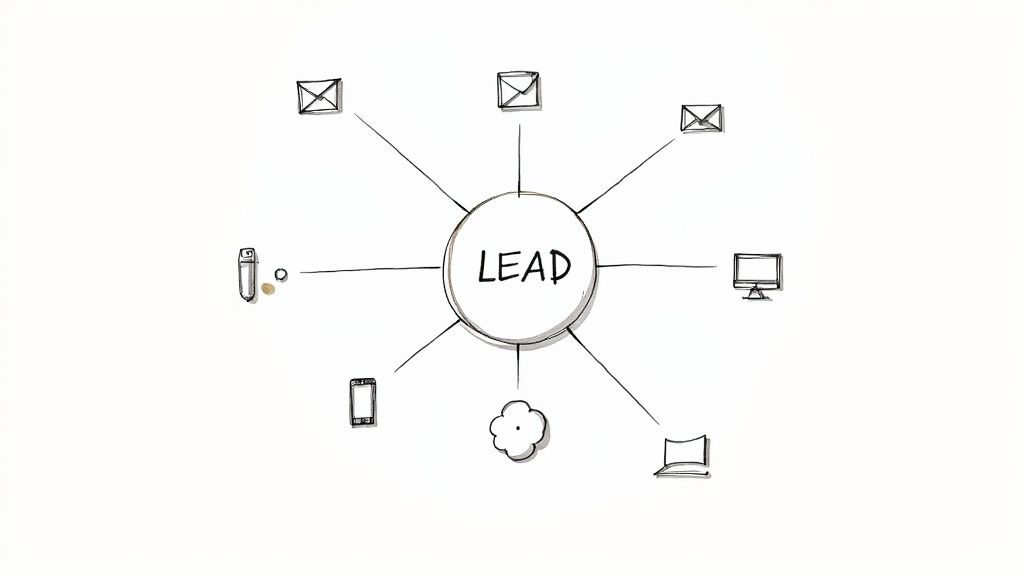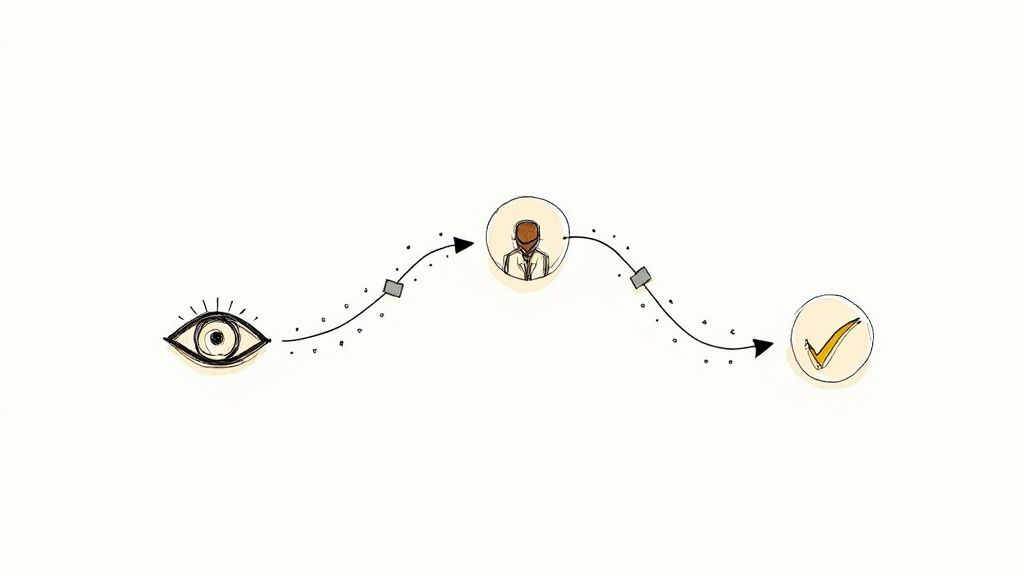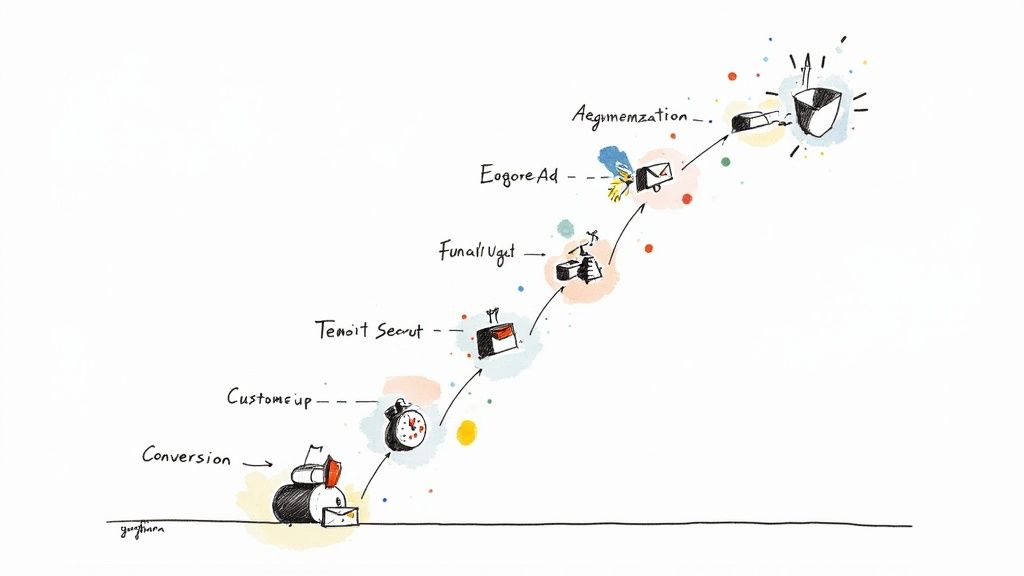Generating leads with Google Ads is only half the battle. The real challenge, and where the highest ROI is found, lies in what you do next. A shocking 48% of businesses don't have a structured lead nurturing strategy, meaning valuable, hard-won leads are slipping through the cracks daily. This guide provides a deep dive into the most effective lead nurturing best practices specifically tailored for the Google Ads ecosystem.
We'll move beyond generic advice and provide actionable, data-driven strategies you can implement to turn clicks into loyal customers. You're spending significant budget to acquire these leads; letting them go cold is a critical waste of resources. This article is designed to bridge the gap between lead acquisition and conversion, ensuring your ad spend delivers maximum value.
From the moment a user submits a lead form to the final conversion, these seven practices will ensure no opportunity is wasted. We will cover proven tactics like advanced segmentation, multi-channel engagement, and automated workflows. By the end, you will have a clear blueprint for building a powerful nurturing system that transforms your Google Ads leads into a predictable revenue stream.
1. Segmentation and Personalization: Treat Google Ads Leads Like Individuals
One of the most effective lead nurturing best practices involves moving away from a one-size-fits-all approach. Instead, you must treat leads as individuals with unique needs. This is where segmentation and personalization become crucial, especially for leads generated through the highly specific environment of Google Ads.
Segmentation means dividing your lead list into smaller, more manageable groups based on shared characteristics. For a Google Ads user, this is a goldmine. You can segment leads based on the exact campaign, ad group, or even the specific keyword that prompted their initial click and conversion. This tells you their precise intent at that moment. Personalization is the next step: tailoring your follow-up communication to the specific pain points and interests of each segment, creating a conversation that feels relevant and valuable.

Why It's a Top Tactic for Google Ads Leads
Leads from Google Ads arrive with high intent but often limited context about your broader brand. A lead who clicked an ad for "emergency plumbing services" has a vastly different, more urgent need than someone who clicked an ad for "kitchen remodel financing." Sending them the same generic welcome email squanders the rich intent data you paid for.
Key Insight: Personalizing communication based on the source Google Ads keyword can increase email open rates by up to 50% because the subject line and content directly mirror the user's initial search query.
Actionable Tips for Implementation
- Start with Campaign-Level Segmentation: Create 3-5 basic segments based on your primary Google Ads campaigns. For example, you might have segments for "Top-of-Funnel Content Keywords," "Branded Search Keywords," and "Competitor Campaign Keywords."
- Use Dynamic Content: In your email marketing platform, use dynamic content blocks that change based on the lead's segment. A lead from a "B2B SaaS" campaign could see a case study, while a lead from a "Small Business" campaign sees a pricing guide.
- Leverage Hidden Form Fields: Pass the Google Ads campaign, ad group, and keyword data through hidden fields on your landing page forms. This automatically populates your CRM, making segmentation effortless and accurate from the very start.
- Combine Implicit and Explicit Data: Use the keyword data (implicit intent) to start the conversation. Then, use progressive profiling in subsequent forms to ask for more information (explicit data) like company size or job role, further refining your segmentation over time.
2. Multi-Channel Lead Nurturing: Go Beyond the Inbox
Relying solely on email to nurture leads is like only using one tool from a full toolbox. One of the most critical lead nurturing best practices is to engage prospects across the various channels they already use. This multi-channel approach involves creating a cohesive journey that might include email, social media retargeting, SMS messages, and even phone calls, ensuring your brand stays top-of-mind no matter where the lead is online.
For leads originating from Google Ads, this strategy is particularly powerful. You've already invested in capturing their initial high intent; a multi-channel strategy ensures that investment is maximized by reinforcing your message across different platforms. It acknowledges that the modern buyer's journey is not linear and that consistent, relevant touchpoints are needed to guide them from initial click to final conversion.

Why It's a Top Tactic for Google Ads Leads
A Google Ads lead is a fleeting opportunity. After they fill out a form, their attention immediately moves elsewhere. If your follow-up is confined to an already crowded email inbox, you risk being forgotten. By retargeting that same lead on LinkedIn with a relevant case study or on Facebook with a compelling video testimonial, you create a powerful omnipresence that builds trust and authority. This approach transforms a single click into a sustained brand conversation.
Key Insight: Companies that use a multi-channel lead nurturing strategy see a 9.5% year-over-year increase in annual revenue, compared to just 3.4% for single-channel companies, demonstrating a direct link between a diverse channel mix and business growth.
Actionable Tips for Implementation
- Create Retargeting Audiences: As soon as a lead converts from a Google Ads campaign, add them to a specific retargeting audience in platforms like LinkedIn, Facebook, and even Google's Display Network. Show them ads that complement your email nurture sequence.
- Coordinate Your Messaging: Ensure the message is consistent but channel-appropriate. An email might contain a detailed whitepaper, while a corresponding social media ad could feature a short, impactful video summarizing the key points of that same whitepaper.
- Use Marketing Automation Triggers: Set up workflows in your automation platform that trigger actions across channels. For instance, if a lead clicks a link in a nurture email, it could trigger an SMS with a special offer or a task for a sales rep to connect on LinkedIn.
- Map the Customer Journey: Before launching, map out the potential touchpoints a lead might have. To truly 'go beyond the inbox' and provide a seamless experience across all touchpoints, it's essential to understand the concept of omnichannel customer service and apply its principles to your marketing efforts.
3. Lead Scoring and Progressive Profiling: Focus Your Efforts on the Best Leads
Not all leads are created equal, especially in the fast-paced world of Google Ads. One of the most crucial lead nurturing best practices is to identify which leads are ready for a sales conversation and which need more time. This is where lead scoring and progressive profiling come in, allowing you to prioritize your efforts intelligently and avoid overwhelming new prospects.
Lead scoring is the process of assigning points to leads based on their attributes and actions, such as their industry, job title, or how they engage with your content. Progressive profiling complements this by gathering information incrementally over time. Instead of asking for everything at once, you use a series of shorter forms, building a richer lead profile with each interaction. Together, they create a powerful system for qualifying leads from your Google Ads campaigns.

Why It's a Top Tactic for Google Ads Leads
Google Ads can generate a high volume of leads, but their quality can vary significantly. A lead from a broad, top-of-funnel "what is" keyword is very different from one who searched a high-intent, bottom-of-funnel "buy now" keyword. Lead scoring helps you automatically sift through this volume, ensuring your sales team only spends time on prospects who have demonstrated genuine interest and fit your ideal customer profile.
Key Insight: Companies that excel at lead nurturing generate 50% more sales-ready leads at a 33% lower cost. Lead scoring is the engine that drives this efficiency by automating the qualification process.
Actionable Tips for Implementation
- Start with a Simple Scoring Model: Don't overcomplicate it. Begin by assigning points for key firmographic data (e.g., company size, industry) and critical behavioral data (e.g., visited the pricing page, downloaded a case study). You can refine this model as you gather more data.
- Set Clear Score Thresholds: Define exactly what score makes a lead "Marketing Qualified" (MQL) and ready for handoff to the sales team. This creates a clear, automated trigger that streamlines the entire lead management process.
- Use Progressive Profiling on Gated Content: For a lead who initially converted on a simple Google Ads form, ask for their job title the next time they download an ebook. On the third interaction, ask for company size. This builds the profile without creating friction.
- Incorporate Negative Scoring: Just as important as positive actions are negative ones. Subtract points if a lead unsubscribes from your email list, visits your careers page, or is from an unqualified industry. This keeps your pipeline clean.
4. Content Mapping to Buyer's Journey: Guide Leads with Relevant Information
One of the most strategic lead nurturing best practices is to align your content with the prospect's mindset at every step. Content mapping is the process of creating and delivering specific content that matches each stage of the buyer's journey: awareness, consideration, and decision. This ensures that leads from your Google Ads receive valuable information that directly addresses their questions and concerns, gently guiding them from initial interest to a final purchase.
This approach acknowledges that a lead's information needs evolve significantly. A user clicking an awareness-stage ad for "what is a CRM" requires fundamentally different content than a user clicking a decision-stage ad for "Salesforce vs. HubSpot pricing." By mapping your content, you create a logical, helpful pathway that builds trust and demonstrates your expertise right when they need it most.

Why It's a Top Tactic for Google Ads Leads
Google Ads campaigns naturally attract users at different stages of the buyer's journey. Top-of-funnel campaigns using broad keywords bring in awareness-stage leads, while highly specific, long-tail, or branded keywords capture leads deep in the consideration or decision phase. Sending a hard sales pitch to an awareness-stage lead is ineffective, just as sending a basic "what is" guide to a decision-stage lead is redundant. Content mapping allows you to nurture each lead appropriately based on the intent data their search query provides.
Key Insight: Companies that excel at lead nurturing generate 50% more sales-ready leads at a 33% lower cost. Mapping content to the buyer's journey is a core component of this success, as it makes every touchpoint more relevant and effective.
Actionable Tips for Implementation
- Audit Content by Journey Stage: Create a simple spreadsheet and categorize your existing assets (blog posts, case studies, webinars) into "Awareness," "Consideration," and "Decision" columns. This will immediately reveal content gaps in your nurturing sequences.
- Align Google Ads Campaigns to Journey Stages: Structure your campaigns to mirror the buyer's journey. Use broad informational keywords for awareness, comparison keywords (e.g., "service A vs. service B") for consideration, and branded or high-intent keywords (e.g., "buy," "quote") for the decision stage.
- Repurpose Existing Content: You don't always need to create new content. Turn a detailed "decision" stage webinar into a series of "consideration" stage blog posts or a short "awareness" stage infographic. This maximizes your content ROI.
- Use Clear Next-Step CTAs: Ensure every piece of content has a call-to-action that guides the lead to the next logical stage. An awareness blog post should offer a more detailed consideration-stage e-book, not a "Buy Now" button.
5. Marketing Automation and Drip Campaigns: Nurture Leads on Autopilot
Manually following up with every single Google Ads lead is inefficient and simply doesn't scale. This is where marketing automation and drip campaigns become essential lead nurturing best practices, allowing you to deliver consistent, timely, and relevant communication without manual intervention.
Marketing automation uses software to send targeted messages based on triggers, such as a lead submitting a form from a specific ad campaign. Drip campaigns are a core component of this, representing a pre-built sequence of emails or messages sent to leads over a set period. This system ensures no lead is forgotten and that each one receives a curated experience designed to move them closer to a purchase decision, saving your team countless hours.
Why It's a Top Tactic for Google Ads Leads
Google Ads leads demand speed and relevance. Automation allows you to respond instantly, 24/7, capitalizing on the moment of peak interest. You can build separate drip campaigns for each Google Ads campaign, ensuring a lead who downloaded an "Advanced B2B SEO Guide" receives different content than one who requested a "Free PPC Audit." This maintains the conversational thread started by their specific search query.
Key Insight: Companies that excel at lead nurturing generate 50% more sales-ready leads at a 33% lower cost. Automation is the engine that drives this efficiency, especially when managing the high volume of leads from paid search campaigns.
Actionable Tips for Implementation
- Map the Journey First: Before you build any workflow, outline the ideal path for a lead from a specific Google Ads campaign. What information do they need first? What's the second touchpoint? What's the ultimate goal? This map becomes the blueprint for your automation.
- Start with a Simple Welcome Series: Your first automation doesn't need complex branching logic. Begin with a 3-5 email welcome sequence for your highest-volume Google Ads campaign. The first email should be sent instantly, confirming their submission and delivering any promised asset.
- Use Behavioral Triggers: Go beyond simple time delays. Trigger automated emails when a lead clicks a link in a previous email, visits your pricing page, or downloads a second resource. This makes your nurturing highly responsive to their actions.
- Combine Education and Calls-to-Action: A great drip campaign provides value before asking for the sale. Structure your sequence to offer helpful tips, case studies, and insights in the first few emails, then introduce a soft call-to-action (like a demo request) later in the sequence. To select the most effective tools for this, exploring options from the Top 10 Best Marketing Automation Platforms For 2025 is a crucial step.
6. Sales and Marketing Alignment (SMarketing): Maximize Your Google Ads ROI
One of the most critical yet often overlooked lead nurturing best practices is the strategic alignment of your sales and marketing teams. This synergy, often called 'SMarketing,' ensures that the valuable, high-intent leads you generate from Google Ads don't fall through the cracks. It involves creating a unified process where both teams share goals, definitions, and feedback loops to convert leads into customers efficiently.
SMarketing transforms the traditional siloed approach into a cohesive revenue engine. When marketing understands what happens to a lead after the form submission and sales has insight into the lead's journey (from the specific keyword clicked to the ad they saw), the entire nurturing process becomes more intelligent and effective. This collaboration ensures every dollar spent on Google Ads is maximized.
Why It's a Top Tactic for Google Ads Leads
Google Ads can generate a high volume of leads with varying levels of purchase readiness. Without alignment, marketing might pass along every form fill, overwhelming sales with unqualified contacts. Conversely, sales might dismiss high-potential leads as "low quality" without understanding the context of their initial search query. A lead from a "competitor comparison" keyword needs a different conversation than one from a "get a quote now" keyword, and SMarketing builds the bridge for that understanding.
Key Insight: Companies with strong sales and marketing alignment achieve up to 36% higher customer retention rates and 38% higher sales win rates, demonstrating the direct impact on revenue from a unified lead management strategy.
Actionable Tips for Implementation
- Create a Service-Level Agreement (SLA): Formally document the responsibilities of each team. Define what constitutes a Marketing Qualified Lead (MQL) and a Sales Qualified Lead (SQL). Specify the exact criteria and timeframe for the sales team to follow up on a lead passed from a Google Ads campaign.
- Establish Closed-Loop Reporting: Connect your Google Ads account, marketing automation platform, and CRM. This allows marketing to see which keywords and campaigns are driving actual sales, not just form fills. Sales, in turn, can see the full history of a lead's interactions, providing crucial context for their calls.
- Hold Regular SMarketing Meetings: Schedule weekly or bi-weekly meetings to review lead quality, discuss conversion rates from specific ad groups, and share feedback. Use this time for sales to share common objections they hear, which marketing can then use to refine ad copy and landing page content.
- Share Revenue-Based Goals: Move beyond separate goals like "cost per lead" for marketing and "number of deals closed" for sales. Instead, create shared KPIs around revenue generated from Google Ads. This ensures both teams are focused on the same ultimate business objective: profitable growth.
7. Behavioral Trigger-Based Nurturing: Respond to Actions, Not Just Timelines
Effective lead nurturing goes beyond pre-scheduled email sequences. The most advanced strategies respond to what a lead does, not just how long they have been in your system. This is the core of behavioral trigger-based nurturing: automatically sending relevant communication in direct response to a prospect's specific actions. It’s a dynamic conversation that unfolds in real-time based on demonstrated interest.
For Google Ads leads, this means you can bridge the gap between their initial high-intent search and their subsequent interactions with your brand. Instead of just sending a generic "7 Days Later" email, you can send a targeted message the moment they revisit your pricing page or download a specific case study. This approach makes your follow-up timely, hyper-relevant, and significantly more effective.
Why It's a Top Tactic for Google Ads Leads
A lead from Google Ads is a hot prospect, but their attention is fleeting. Behavioral triggers allow you to re-engage them at critical moments in their decision-making process. If a lead from a "Salesforce competitor" campaign later visits your CRM integration page, a triggered email highlighting your Salesforce sync capabilities can be the final nudge they need. This real-time relevance is something a static, time-based workflow can't replicate.
Key Insight: Leads nurtured with personalized, behavior-triggered content produce a 20% increase in sales opportunities compared to non-triggered, generic nurturing campaigns. This is because the follow-up directly addresses their most recent interest.
Actionable Tips for Implementation
- Start with High-Intent Behaviors: Set up your first triggers for high-value actions. Key examples include a lead visiting your pricing page a second time, watching more than 75% of a product demo video, or using your on-site ROI calculator.
- Trigger for Engagement and Disengagement: Don't just reward action; respond to inaction. Create a "re-engagement" trigger for a lead who hasn't opened an email or visited your site in 30 days, offering them a compelling new resource to bring them back.
- Keep It Helpful, Not Stalky: The goal is to be relevant, not creepy. Frame your triggered messages from a helpful perspective. Instead of "We saw you visited our pricing page," try "Deciding on the right plan can be tough. Here’s a guide to help you choose."
- Inform Your Sales Team: Use these behavioral triggers to create alerts for your sales team. A lead who downloads a "Buyer's Guide" and then visits the pricing page within the same day is a highly qualified prospect who warrants immediate, manual outreach.
Lead Nurturing Best Practices Comparison
| Item | Implementation Complexity 🔄 | Resource Requirements ⚡ | Expected Outcomes 📊 | Ideal Use Cases 💡 | Key Advantages ⭐ |
|---|---|---|---|---|---|
| Segmentation and Personalization | Medium to High – needs data setup and ongoing maintenance | High – significant data collection and management needed | Improved engagement and conversion rates; reduces unsubscribe rates | Businesses with rich customer data seeking tailored messaging | Higher open & click rates; better customer experience |
| Multi-Channel Lead Nurturing | High – requires coordination across many channels | Very High – cross-team and budget intensive | Stronger brand recall; increased campaign effectiveness (up to 250%) | Complex campaigns targeting audiences on multiple platforms | Multiple conversion opportunities; reduces channel dependency |
| Lead Scoring and Progressive Profiling | Medium to High – complex initial setup plus calibration | Medium – CRM integration and data analysis needed | Better sales focus on qualified leads; conversion improvements | Prioritizing and qualifying leads for sales follow-up | Increases sales alignment; targeted nurturing efficacy |
| Content Mapping to Buyer's Journey | Medium – requires content planning and tracking | High – substantial content creation and analytics | Faster lead progression through funnel; improved content ROI | Businesses with detailed buyer stages and content strategies | Enhances content relevance; aligns sales-marketing messaging |
| Marketing Automation and Drip Campaigns | Medium – setup of automated workflows and triggers | Medium to High – technology, content, and expertise | Scalable nurturing; 451% lead conversion uplift | Automating repetitive communications to scale lead engagement | Saves time; consistent follow-up; detailed performance data |
| Sales and Marketing Alignment (SMarketing) | High – organizational change and ongoing collaboration | Medium to High – tools and cross-team commitment | Up to 67% conversion increase; better forecasting and lead management | Organizations seeking unified sales-marketing processes | Reduces lead leakage; improves lead quality and productivity |
| Behavioral Trigger-Based Nurturing | Medium to High – requires advanced tracking and trigger setup | Medium to High – analytics and automation platforms | Timely, relevant outreach; increased engagement and conversions | Real-time responses based on user actions | Captures interest at peak moments; personalized communication |
Turn Your Google Ads Leads into Lasting Revenue
Transforming a click into a customer is where the real work begins. Generating leads through Google Ads is a significant achievement, but without a robust follow-up strategy, that initial investment can easily be wasted. The journey from a qualified lead to a loyal customer is built on a foundation of trust, relevance, and timely communication. Implementing the lead nurturing best practices we've covered is the blueprint for building that journey effectively.
The core principle is simple: treat each lead not as a data point, but as an individual with unique needs and challenges. Moving beyond generic, one-size-fits-all communication is no longer optional. It's the standard for success. By strategically applying these tactics, you create a system that works for you, turning your Google Ads campaigns into a predictable and scalable revenue engine.
Key Takeaways for Maximizing Your Google Ads ROI
Let's distill the most critical insights from this guide into a clear action plan. Mastering these concepts will fundamentally change how you approach the post-click experience.
- Segmentation is Your Foundation: Start by dividing your leads based on their source campaign, ad group, or the specific keywords they used. This initial context is your best starting point for personalization.
- Automation Delivers Consistency: Use marketing automation to create email workflows and drip campaigns that deliver the right message at the right time, ensuring no lead ever falls through the cracks.
- Content is the Conversation: Map your content assets, from blog posts to case studies, directly to the different stages of the buyer's journey. Provide value and education first, and the sale will follow.
- Align Sales and Marketing: True lead nurturing success happens when your sales and marketing teams operate as one cohesive unit (SMarketing). Shared goals, clear lead scoring definitions, and consistent communication are non-negotiable.
Ultimately, these lead nurturing best practices are about building relationships at scale. You are proving to each prospect that you understand their problem and are uniquely positioned to solve it. This approach doesn't just increase conversion rates; it builds a stronger brand reputation, fosters customer loyalty, and significantly improves the long-term value of every lead you acquire through Google Ads. Don't let your hard-earned leads go cold. The time to implement a strategic nurturing process is now, turning your ad spend into a powerful, sustainable source of growth.
Ready to close the gap between lead capture and first contact? Pushmylead eliminates the delay by instantly sending your Google Ads Lead Form submissions directly to your email inbox, ensuring you can act while the lead is still hot. Start turning more clicks into customers by visiting Pushmylead and ensuring your nurturing sequence begins the moment a lead shows interest.
